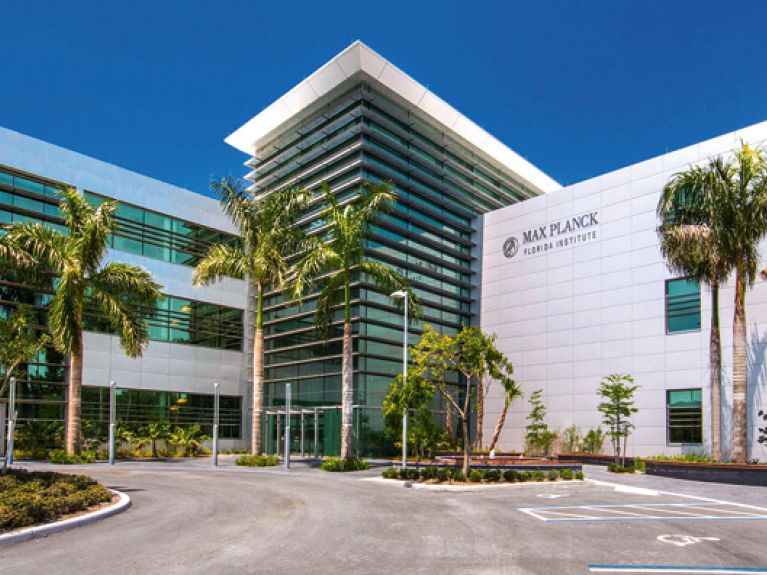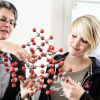Outstanding outposts
The Max Planck Society is also engaged in cutting-edge research at three high-profile locations in North America.

Cutting-edge research thrives when the world’s best researchers cooperate closely. For the Max Planck Society, however, international conferences, one-time cooperative projects and a joint discussion of the latest publications are not enough. That is why it maintains a worldwide presence, including at three locations in North America.
“Jupiter, Florida, was not exactly a science hub,” recalls Bert Sakmann, the German Nobel laureate in Medicine who served as scientific director of the Max Planck Florida Institute for Neuroscience during the institute’s startup phase beginning in 2009. Located on the campus of Florida Atlantic University, it is the first Max Planck Institute in the United States. The organization’s goal is to engage in a range of neuroscience research, from imaging processes to analysis of unexplored brain activity. The idea to found the institute came from Florida’s then governor, Jeb Bush, after he visited Bavaria. In Martinsried near Munich he saw how an entire region was flourishing near two Max Planck Institutes. Bavaria’s Biotech Valley was the role model for Jupiter and prompted the state of Florida and the local county to contribute startup funds of almost 200 million dollars.
Nine working groups are now examining basic processes in the brain. They want to better understand how neurons relay information and how illness can cause dysfunction. “With that we’ve achieved a critical mass of researchers,” Sakmann says. The professor emeritus of medicine is particularly proud of having found David Fitzpatrick during the startup phase to serve as his highly committed successor. As one of the leading neuroscientists in the US, Fitzpatrick has been leading the institute in Jupiter since 2011. “The Max Planck model allows us to generate knowledge at an incredible level,” he says.
It does so by offering researchers a great deal of freedom, even by American standards. Brilliant young scientists are given generous funding that allows them to work at length on their ideas instead of spending their valuable time filling out grant applications. “That means we can take risks and head in completely new directions,” says Fitzpatrick. “Even American decision makers, who had never heard of Max Planck, are enthusiastic about our model.” He notes that the Florida team is responsible for a growing number of articles in respected journals and that its research is resulting in new treatments for neurological disorders, treatments that are being developed in ever closer cooperation with Florida Atlantic University and the Scripps Research Institute’s newly founded Florida branch.
“I can only recommend launching partnerships like these in other research fields as well,” says Fitzpatrick, looking beyond Florida. Exactly that has been happening since 2012 in Princeton – and in Canada, where the Max Planck–UBC Center for Quantum Materials has been cooperating closely with the University of British Columbia in Vancouver since 2010. In contrast to Florida, the focus there is not on building a completely new research facility. The center functions as a platform instead, one that networks basic researchers from nine German Max Planck Institutes with the University of British Columbia, thereby facilitating joint projects and a transatlantic exchange among scientists. The goal is to gain a better understanding of quantum effects in a range of substances. Potential innovations include new superconductors allowing resistance-free electricity transmission; more efficient catalysts for the chemical industry; and new materials with exotic characteristics.
The Max-Planck-Princeton Center for Plasma Physics is focusing on processes that play a key role in nuclear fusion and in astrophysicists’ attempts to understand distant suns. In the United States, Princeton University has long been a leader in the area of fusion research, one that could become an incredibly productive source of energy in the near future. Max Planck institutes in the German cities of Garching, Göttingen and Greifswald are participating in the effort. “We want to make the Max Planck Society and its expertise better known in the US,” says Sibylle Günter, director of the Max Planck Institute for Plasma Physics in Garching. “Thanks to the increasing number of joint projects and workshops, our efforts in this area are now beginning to bear fruit.”
The Max Planck Society has already won over many decision makers and cutting-edge researchers in North America. “The research landscape in the US can benefit enormously from following approaches similar to those found in Germany,” says David Fitzpatrick. Conversely, American scientists are becoming increasingly interested in German institutes, whether it be for working there temporarily or engaging in long-term partnerships.

